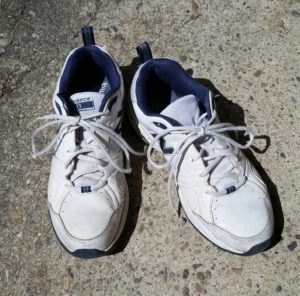 Views about exercise and aging have really changed over the last century. Bottom line: walk - it's good for cognitive health, especially as you age. Try for at least 1 mile per day (1 mile = approx. 20 minutes brisk walk).
Views about exercise and aging have really changed over the last century. Bottom line: walk - it's good for cognitive health, especially as you age. Try for at least 1 mile per day (1 mile = approx. 20 minutes brisk walk).
From The Atlantic: Walking for a Better Brain
A “nerve specialist” from New York named J. Leonard Corning said in 1909 that he was opposed to “excessive exercise,” ... He thought that with the “over-cultivation of the physique the mentality suffered.” Corning wrote during a period when experts widely believed that brain cells didn’t regenerate. As a result, graceful aging was in large part a matter of learning to cope with gradually diminishing brain capacity. Modern science has shown that’s not the case; we do generate new brain cells throughout our lives, although the process can become increasingly imperfect and less efficient with age, as it does with much cellular activity.
One of the largest studies ever conducted was on a group of 121,000 nurses, who were surveyed on a wide range of their health and lifestyle habits starting in 1976. The survey was repeated every two years. This established a trove of valuable information, which public-health researchers have been fruitfully mining since. Among them is Rush University assistant professor Jennifer Weuve, who studied the data collected on 18,766 of the nurses, who were then ages 70 to 81, to unearth connections between exercise and cognitive ability. The results, published in The Journal of the American Medical Association, suggested that those who exercised the most—the group that maintained a median level of walking for six hours a week—were 20 percent less likely to show cognitive impairment than those who exercised the least.
Other long-term studies also show that even modest exercise can serve
as a bulwark against dementia. A study started in 1989 with 299 elderly
volunteers in the Pittsburgh area tracked mental acuity and exercise habits....The results, published in the journal Neurology, were sweeping and conclusive: Those who walked the most cut in half their risk of developing memory problems. The optimal exercise for cognitive health benefits, the
researchers concluded, was to walk six to nine miles each week. That’s a mile to a mile and a half a day, without walking on Sundays if you’re inclined to follow Weston’s example of resting on the Sabbath. (This study concluded that walking an additional mile didn’t help all that much.)
A study written up in the Archives of Internal Medicine in 2001 tracked nearly six thousand women ages 65 and older for six to eight years. The women were given a cognitive test at the study’s beginning and end, the results of which were then correlated with how many blocks they walked daily. Those who walked the least had a drop of 24 percent in cognition. Those who walked the most still showed a decline, but of a lesser degree: 17 percent. The results were clear: “Women with higher levels of baseline physical activity were less likely to develop cognitive decline.”
Peter Snyder of Brown University’s Alpert Medical School, who studies the effects of aging on the brain, recently told National Public Radio that “what we’re finding is that of all of these noninvasive ways of intervening, it is exercise that seems to have the most efficacy at this point—more so than nutritional supplements, vitamins and cognitive interventions ... The literature on exercise is just tremendous,” he said.
Indeed, a 20-year-long study in 2010 found that walking just five miles per week “protects the brain structure” over a 10-year period in people with Alzheimer’s disease and in those who exhibit signs of mild cognitive impairment. “The findings showed across the board that greater amounts of physical activity were associated with greater brain volume,” the researchers concluded.
While different studies arrive at moderately different conclusions via various routes, the recent research of dozens of scientists more often than not converges at a single intersection. And that consistently suggests that if you exercise, your brain will be fitter than if you don’t. This applies to the young, those in the prime of their days, and especially to the elderly.
The 20-year 2010 study mentioned above, results from which were released by Cyrus Raji of the University of Pittsburgh, followed 426 older adults, including healthy people along with those showing mild cognitive impairment or the actual onset of Alzheimer’s. Across test subjects, more walking was shown to result in greater brain volume. “Unfortunately, walking is not a cure,” Raji said. “But walking can improve your brain’s resistance to [Alzheimer’s] disease and reduce memory loss over time.”
 The bottom line: for better health be physically active at least is 2.5 hours of week. Note that HbA1c is a measure of glycated hemoglobin which identifies average plasma glucose concentration (and lower is better). From Medscape:
The bottom line: for better health be physically active at least is 2.5 hours of week. Note that HbA1c is a measure of glycated hemoglobin which identifies average plasma glucose concentration (and lower is better). From Medscape: